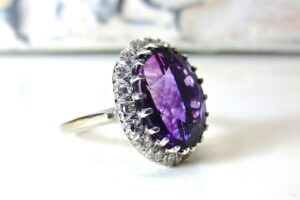The Royal Stone. Shopping For Amethyst
Obviously there is more to jewelry than just precious metals. From times immemorial people, and women in particular, understood that certain stones not only complement their looks but also make them feel good. One such gem is the vivid purple amethyst. As one the most valuable varieties of quartz, it has been celebrated for centuries as the jewel of the royals and until the discovery of large deposits in Brazil was as expensive as finest rubies and emeralds. Today amethyst is in demand for designer pieces and mass market jewelry alike. However, because of the lack of a global standardized amethyst grading system, we felt the need to compile a few interesting and useful facts relating to this beautiful gem, and make shopping for amethyst jewelry easier.
THE LEGEND ...
Because of its magnificent grape-juice color, the ancient Greek myths associated amethyst with Bacchus – the Greek god of wine. Curiously enough, the Greek word “amethystos” means “not drunk,” or “not leading a wild life.” It suggests that the Greeks believed the amethyst to be able to actually protect them against drunkenness. As funny as it may seem to us today, they carved amethyst goblets to keep themselves from getting too, shall we say “lost.”
A different Greek story explains amethyst’s origins like this. Angered by a mortal’s insult Bacchusswears revenge on the next one that crosses his path. To help himself with the task he brings to life wild tigers, planning to unleash them upon an unfortunate and unsuspecting victim. He doesn’t expect the mortal to be a beautiful young maiden by the name of Amethyst, on her way to pay tribute to the goddess Diana. Aware of Bacchus’ wicked plan, and to protect her from the brutal claws of the tigers Diana turns Amethyst into a statue of pure crystalline quartz. Looking at the beautiful statue and realizing what has happened, Bacchus weeps tears of wine and sorrow. His tears stain the quartz purple, and the gem we all know and treasure today comes into existence.

Both myths reflect Greek belief that amethyst keeps its wearer clear headed and quick witted in battle, and in business affairs. As to which one of the two stories sounds more plausible, we’ll leave up to you. However, the beauty of the amethyst remains undisputable.
Amethysts fame does not end here. In Tibet, it is still Buddha’s favorite gemstone and Tibetans use the stone to fashion prayer beads from it. It was also one of the 12 stones embedded in the breastplate worn by the high priest of the ancient temple at Jerusalem. Later European traditions tell us that the patron saint of romantic love, Saint Valentine wore an amethyst ring with engraved cupid so that Roman soldiers could recognize him and ask for his marriage services. In the Middle Ages amethyst was recognized as a symbol of royalty, with the English coronation regalia being decorated with it. Today Amethyst is celebrated as the birthstone for the month of February as well as the gem for the 6thand 17th wedding anniversaries.
COLOR IS THE MOST IMPORTANT ...
Amethyst color ranges from light lilac to bright red-violet and its value depends on it almost entirely. Its purple hue is the result of a chemical reaction between organic substances and iron impurities. Red-violet shades are considered most valuable while weak or light colored ones are worth considerably less. An interesting and distinct feature of amethyst is its ability to change color. Exposed to sunlight, it loses some of it, or even turns pale if left in the sun for longer period of time. This is due to the gem’s reaction to temperature and once it cools, the color gradually comes back.
CLARITY & LUSTER …
Gem’s clarity is understood as the lack of visible defects inside as well as on the outside. Because amethyst is a Type2 gemstone (usually imperfection-free), the internal inclusions should be as few and as small as possible. Because of the gemstone’s wide availability there is no need to buy an included stone so when shopping for one look at it in a well-lit setting, and see if it looks eye clean.
OTHER CHARACTERISTICS …
Amethyst is a quartz and because of that it is a relatively hard stone. It’s hardness on a Mohs’s scale is 7, with 10 (attributed to diamond) being the hardest. This durability makes it an excellent fit for any gem setting. To emphasize the natural beauty of amethysts gem cutters often choose oval, considered to be the standard shape for the stone. It is not uncommon however, to find jewelry set with heart, triangle, pear and square shaped amethysts. The rare and expensive ones are given step or mixed cut just like diamonds, while the less expensive are cut as cabochons. Since the amethyst is a relatively affordable gem today, one can usually get a bigger one, of high quality without drastically increasing the price. This makes it an excellent choice for a center stone especially when surrounded by small diamonds or other accenting jewels.
Amethysts are beautiful, and carry within special and alluring energy. If you are interested in purchasing a piece of amethyst jewelry, or an unmounted stone please contact us at [email protected]and one of our gem & jewelry specialists will help you find one right for you





